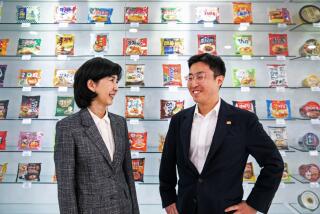S. Korean Firm Strives for Top of High-Tech Industry
- Share via
SEOUL, South Korea — Samsung Group, whose cheap TVs, microwaves and personal computers have hit it big on the American market, now has ambitions to become one of the world’s top high-tech makers by the early 1990s.
Samsung, among South Korea’s three biggest chaebol , or business conglomerates, says it also intends to diversify into the chemical sector, building a huge complex to produce hundreds of thousands of metric tons of ethylene-based oil products by 1992.
The expansion plans, which business sources say are bold even for such an experienced group, are the fruit of the new thinking at Samsung since Lee Kun-hee took control after the death in November, 1987, at age 77 of his father, founder Lee Byung-chull.
The group announced in June that it would merge its flagship companies, Samsung Electronics Co. and Samsung Semiconductor & Telecommunications Co. (SST), as early as November.
The merger will streamline the two companies’ sometimes overlapping production of electronic items. “We want to be in the world top five makers of high technology by the early 1990s,” said one senior Samsung executive who declined to be identified.
Samsung Electronics’ range of home appliances includes color televisions, videocassette recorders and refrigerators, personal computers and microwave ovens. Some 75% of their products go for export.
SST makes semiconductors including 64-kilobyte DRAM (dynamic random-access memory) and 256-k DRAM chips, and has developed a one-megabyte DRAM chip due to go into mass production early in 1989, the company says. It produces 7 million 256-k DRAM chips a month.
SST, like its sister company, also produces personal computers. Sales have been so good that it doubled this year’s export target to more than 60,000 units from 30,000 in 1987, mostly sold to the United States.
More Competitive
Samsung Electronics, meanwhile, expects to sell 250,000 units abroad in 1988, sharply up from about 100,000 exported last year, the majority again to the American market.
With the merger, these separate personal computer sales and production efforts will end, the official said.
“The company will be better prepared to cope with harsh international market conditions, including U.S. protectionist efforts,” he said.
Seoul’s growing trade surplus in the past two years has brought criticism from the United States and other trading partners. Under heavy American pressure, South Korea’s currency, the won , has been revalued more than 8% this year after an 8.72% rise in 1987.
The Samsung merger was designed to pair products with technology in the electronic sector, on the model of advanced countries such as Japan, the official explained.
“We also want to lower the ratio of our sales given over to consumer electronics, in favor of more profitable industrial and office automation,” he said.
One U.S. analyst in Seoul, Bill Stoops of Citicorp Scrimgeour Vickers, said Samsung Electronics, as a consumer electronics maker, would benefit from having an in-house chip manufacturer just like its Japanese competitors.
More to Read
Inside the business of entertainment
The Wide Shot brings you news, analysis and insights on everything from streaming wars to production — and what it all means for the future.
You may occasionally receive promotional content from the Los Angeles Times.










